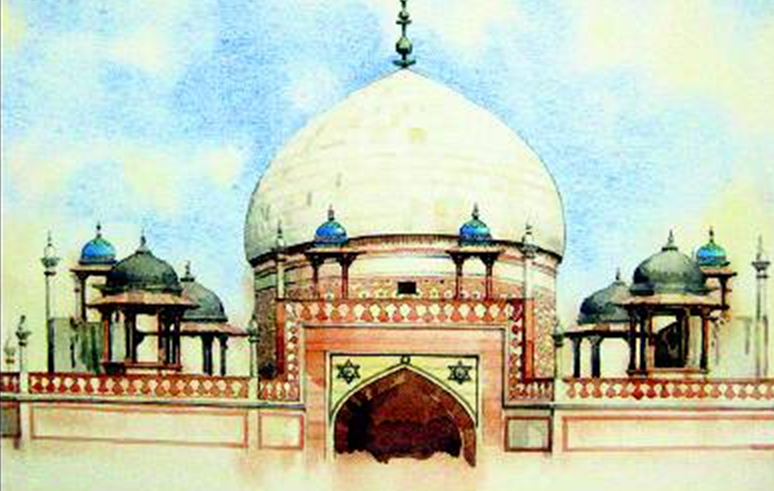Delhi: Humayun’s Tomb Complex
This is a collection of articles archived for the excellence of their content. Readers will be able to edit existing articles and post new articles directly |
Contents |
History
The eight canopies on Humayun’s Tomb were originally covered with ceramic tiles in lapis blue, turquoise blue, green, white and yellow Tile-making techniques used by the Mughals have been lost over the centuries and very little in terms of conservation has been done when the tiles have been vandalised, fallen or simply gone missing.
Traces of the original tile work on the canopies of Humayun’s Tomb helped reveal the original pattern of the tiles Built in Mughal emperor Humayun’s memory in 1562 by his widow Hamida Begum, Humayun’s Tomb was the first structure to use red sandstone on such a large scale and also the first garden-tomb in the Indian subcontinent. It was given Unesco world heritage status in 1993
International appreciation
1992: Status of “World Heritage Site” by UNESCO
The Times of India, Jul 15 2015

Richi Verma
More than 20 years after Humayun's Tomb was declared a world heritage site, six other monuments around it have been covered in the same glory . This has been made possible by a boundary clarification and retrospective recognition for the other monuments within the complex as “contemporary 16th-century garden tombs within the property forming a unique ensemble.“
After the statement issued by Unesco, a United Nations agency , Nila Gumbad, Afsarwala Complex, Isa Khan's garden tomb, Bu Halima garden tomb and Arab ki Serai are officially part of the World Heritage site. The heritage zone of the complex has thus more than doubled from 26 acres to 54 acres, and its buffer zone has also increased.
The decision was made last week in a session of the World Heritage Committee held in Bonn, Germany . An Archaeological Survey of India (ASI) official said the 11-acre Batashewala complex where conservation was recently completed is now in the buffer zone. So are Sundarwala Mahal and Sundarwala Burj inside Sunder Nursery and Sabz Burj on Mathura Road.
The decision came after ASI suggested in its periodic reporting to Unesco that the integrity and authenticity of the World Heritage site were a result of Humayun's Tomb being an ensemble of contemporary garden-tombs. “Unesco New Delhi welcomes the formalization by the World Heritage Committee of the World Heritage Site property boundaries to in clude six additional gardentombs in the Humayun's Tomb complex on the basis of the revised statement of outstanding value,“ said Moe Chiba, programme specialist for culture at Unesco's Delhi office.“It is a significant achievement and provides due acknowledgement to the years of conservation effort at Humayun's Tomb. This will serve as a basis of improved site management to meet World Heritage objectives and enhanced visitor experience. Ratish Nanda, project director, Aga Khan Trust for Culture, which is working on an elaborate urban conservation project in Humayun's Tomb complex since 2007, said: “This ratification of the boundary proposed by the ASI and recognition of the site being an ensemble allows steps to be taken for its effective management as well as future extension to include other contemporary 16th-century structures within the World Heritage property .
According to the Unesco website, the 1992 nomination by India mentioned only Humayun's Tomb, listing its significant architectural elements. As a result, the recognition was only granted to the garden-tomb, and other monuments outside the 26acre property were included in its buffer zone. World Heritage Committee meeting documents now recognize, “Humayun's Tomb and the other contemporary 16th-century garden tombs within the property form a unique ensemble of Mughal-era garden-tombs.The monumental scale, architectural treatment and garden setting are outstanding in Islamic garden-tombs. The Unesco statement for inclusion of the six monuments in the World Heritage list also recognized that “Humayun's Tomb and its surrounding structures are substantially in their original state and conservation works have been of high quality--carried out using traditional materials such as lime mortar to recover authenticity by removal of 20th-century materials such as concrete.
Lost architectural marvels
Crown jewels
ASI And Aga Khan Trust Will Rebuild The Tiles On Eight Canopies Of The Sixteenth Century Monument, In The Original Colours And Using The Original Blueprints Richi Verma | TNN
World heritage site Humayun’s Tomb is all set to regain its lost architectural marvels. The eight canopies on the dome of the 16th century monument — which originally had striking blue, yellow and green colour tiles — will be restored as per the original Mughal design and architecture.
Experts said that the process of rebuilding the tiles was a very long process and involved detailed studies aimed at understanding the original design and composition of the Mughal-era tiles.
Archaeological Survey of India (ASI) director-general K N Shrivastava said: ‘‘We are going to reconstruct the original blue tile work on the canopies of the monument. Since the monument is a world heritage site, we will have to keep Unesco updated about the plan and also about the progress of the conservation work. Under the principles of conservation, monuments have to be conserved according to the original design and shape. Reconstructing the lost blue tile work is a structural requirement of the tomb.’’
According to ASI officials, the smaller canopies on the roof of the tomb were originally decorated with ceramic tiles in lapis blue, turquoise blue, green, white and yellow as was the tradition at that time. ‘‘These striking colours were highlighted by the contrasting milky whiteness of the marble dome in the background. During the early 19th century, most of the original tiles started peeling off. Only traces of them remain today,’’ said a senior ASI official.
Experts said that traces of tile work that remained have helped reveal the original pattern, and laboratories in Roorkee, Oxford and Barcelona have tested the tile samples. ‘‘An international workshop — co-sponsored by Unesco and ASI — on conservation of Humayun’s Tomb tile work was held in April 2009 to discuss, debate and find possible solutions for conservation of tiles on the tomb’s canopies, including restoration of the missing tile work,’’ added officials. About 40 participants from nine tile producing countries of Afghanistan, Bangladesh, India, Iran, Kyrgyzstan, Pakistan, Tajikistan, Turkmenistan and Uzbekistan participated in the workshop.
According to historians, tile work is a significant element in several Lodhi and early Mughal period structures and remnants of tile work can be seen on several monuments in Delhi. However, the tile-making traditions followed by the Mughals have been lost over the centuries and hence very little in conservation terms could be done when the tiles have fallen, vandalised or simply gone missing.
Tile work is a significant architectural element, and it also protects the underlying surface. The loss of tile work severely disfigures the historic architectural character/integrity of the monument.
‘‘Conservation of existing tile work should be a priority at all sites and efforts should be made to minimise further loss of the original tiles. Any new tile work that will replace missing tiles should match the original ones in colour, texture, composition and other physical and chemical properties and the conservation work should respect the original patterns,’’ said Ratish Nanda of Aga Khan Trust for Culture (AKTC).
AKTC will also train youths of Nizamuddin Basti to produce Mughalstyle tiles and to preserve tile-making traditions in the country.
The conservation work at the Humayun’s Tomb is part of a publicprivate partnership between the ASI, AKTC, Central Public Works Department (CPWD), Municipal Corporation of Delhi (MCD) and Aga Khan Foundation.
Some months ago, ASI and AKTC officials had removed a thick layer of cement concrete from the roof of the mausoleum. The concrete was putting a pressure of about 10 lakh kilos on the structure. This layer that had been added to the monument during the British rule to prevent water seepage also blocked the water drainage channels on the roof, leading to accumulation of rainwater causing considerable damage to the monument.
April 2016: Restoration of finial
The Times of India, Apr 20 2016
Richi Verma
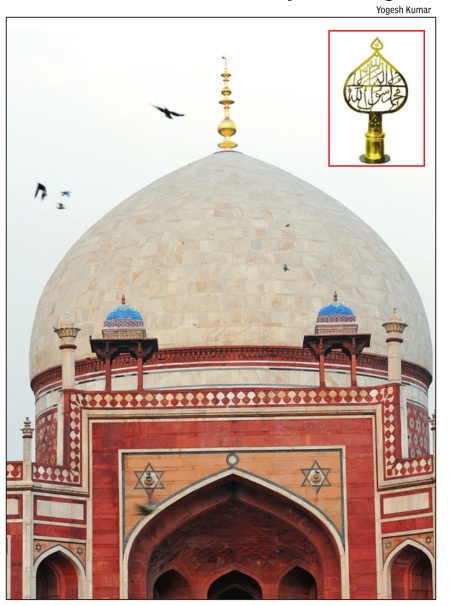

Humayun's Tomb Gets A New Finial Two Years After Storm Blew Away The Original
Fhe 16th-century tomb of Mughal emperor Humayun has got back its finial that it had lost two years ago to a sandstorm. Union culture minister Mahesh Sharma unveiled the new 18-foot structure, which is adorned with 3.5kg gold and which took two years of intense labour to put together.
“After two years of hard work, the finial or kalash of Humayun's Tomb has been restored. This architectural element, built of almost 100% pure copper, was inspired by the kalash seen on Hindu temples and represents the pluralistic Indian architectural traditions,“ the minister said.
Referring to Prime Minister Narendra Modi's Make In India initiative, Sharma added, “For two years, carpenters, coppersmiths, goldsmiths and masons worked with their traditional tools and techniques that have stayed alive in India for centuries. These combined with the application of modern technology has helped create an authentic replica of the Humayun's Tomb kalash for this Unesco World Heritage Site. This is truly Make In India.“
Finials seen on tombs of the Sultanate period were generally only about three to five feet in height. But an 18-foot finial on the Humayun's Tomb set a grand trend for Islamic buildings. “The core of it was a 22foot tree log on which were fixed 11 vessels of pure copper crowned by a brass inscription--the whole finished by the Mughals with layers of pure gold,“ said an expert.
The Taj Mahal later used a similar copper finial. “Just as the chhatris or canopies on the roof of the tomb are inspired from Rajput architecture, similarly the coppergold finial erected here seems to have been inspired by temple architecture and built precisely to fit the dome profile,“ said an official.
The restored finial comprises a 22foot octagonal log of wood, 300 kilos of copper, a brass inscription, and at least six layers of gold foil gilding completed by brushing glass beads.“Authenticity was achieved since the finial matches the original exactly in weight and profile for each of the 11 vessels; is built of material exactly matching those used by the Mughals in the 16th century; continues to crown the white marble dome, representing the pluralistic architectural traditions employed by the Mughals; is a product of living craft traditions that have been passed down for generations in craftsmen families,“ said an official.
CROWNING GLORY
How a Mughal marvel was recreated The Humayun's Tomb, built during the reign of Emperor Akbar, was a grand announcement--that the Mughals had arrived and were there to stay. No effort was spared to make it stand out from other monuments erected by the Sultans of Delhi. So the emperor's tomb was crowned by an 18-foot finial, which was made of 11 pure-copper vessels fitting a 22-foot wooden log and a brass inscription on top. The whole thing was then finished with layers and layers of pure gold--a Mughal style statement. But over the centuries, it suffered wear and tear and needed several repairs--works that were recorded for posterity on the finial itself. One of the last major efforts of restoration was undertaken during the British Raj in 1912 when the finial was taken down to insert a lightning conductor.But on May 30, 2014, the log snapped in a storm and the finial came crashing down. This time, it was decided to make a whole new finial matching the original design, weight and the use of metals. And as it turns out, the new finial is as good as the original. Mughal grandeur has been recreated.
As in 2023
Anuja Jaiswal, Dec 15, 2023: The Times of India

From: Anuja Jaiswal, Dec 15, 2023: The Times of India
New Delhi : The replica graves of Humayun, the second Mughal emperor, and his family on the first floor of the tomb complex are crying for repair, upkeep and deep cleaning, despite their being part of the Unesco World Heritage Site. Though Archaeological Survey of India officials claimed that the graves and the tomb complex were cleaned at least four times a year, dust has blackened the marble dome. The corners and platforms of some of the graves are broken and the plaster on the outer walls of some of the cells of the tomb has chipped off. The motifs on the walls in some cells have also disappeared under a coating of grime. Besides, one of the doors in the basement of the tomb, where the real graves lie, is broken and lists to the side.
The mausoleum is located in the centre of the tomb complex and rises from a podium with a series of cells with arched openings. The cenotaph of the ruler is located in the centre of the upper tier in a large room decorated with several rows of arched windows. The central chamber is octagonal with corner-chambers that house the graves of other imperial members. The real grave of the emperor is in the basement. It is built of red sandstone, but white and black marble has been used to relieve the monotony.
The person in charge of Humayun’s Tomb said that floor mopping was done every day, but pigeon droppings had left stubborn stains on the surface. Cleaning of the entire tomb with water is done four times a year.
Experts said that dust at the base of the cenotaph needed to be cleared and the dirty floors needed to be given a good scrub. Tourists visiting the monument carry dust into the tomb and constant touching by the visitors has left the marble surface soiled. The experts felt the graves should be bounded off to prevent people touching them. According to ASI, the tomb was built by Humayun’s senior widow, Bega Begam, popularly known as HajI Begam, nine years after his death in 1565, according to some, and 14 years later according to an 18th century text. It is the first substantial example of Mughal architecture, with high arches and double domes.
ASI officials said that several rulers of the Mughal dynasty lie buried in the mausoleum. There are around 150 graves and it has not been pos sible to identify all these. Among those identified as buried here are Bega Begam, Humayun’s junior wife Hamida Banu Begum, Shah Jahan’s son Dara Shikoh and the later Mughals, among them Jahandar Shah, Farrukhsiyar, Rafiu’d-Darajat, Rafiu’d-Daula and Alamgir II. Bahadur Shah Zafar II, the last Mughal emperor of Delhi, had taken shelter in this tomb with his three sons during the war of 1857 and was captured there by Captain William Hodson.
Exemplifying the formative stage of the dynasty’s structural style, Humayun's Tomb stands as a landmark in the development of Mughal architecture. It also represents the earliest extant specimen of the Mughal scheme of the garden tomb, with causeways and channels. Although some tombs had already been sited within gardens, it is the first mature example of the idea of garden-tomb, which culminated in the Taj Mahal at Agra.
The 11 surrounding tombs
The Times of India, Dec 18 2016

Humayun's Tomb unites with 11 cousins
Richi Verma
Unesco adds 7 more contemporary garden tombs to buffer zone; 4 were added in 2015
The profile of Humayun's Tomb has been enhanced. Nearly a dozen other garden tombs in the vicinity of the grand 16thcentury Mughal edifice have also been designated as monuments of outstanding universal value by Unesco and recognised as world heritage.
While four of these structures got the prestigious tag in 2015, seven others were included as world heritage property through a notification in 2016. Officials say this is the first-ever expansion of a world heritage site.
In 2015, one the request of Aga Khan Trust for Culture and Archaeological Survey of India, Unesco included Isa Khan's Tomb, Bu Halima's Tomb and Garden, Afsarwala Garden Tomb and Arab Se rai Bazaar as part of the world heritage site. In early this year, AKTC proposed further boundary modification, whI ich was forwarded by the Centre to Unesco. “Seven other 16th-century garden tombs have been included. These are Lakkarwala Burj, Sunder Burj, Sunderwala Mahal, Mirza Muzzafar Hussain's Tomb, Chotte Batashewala Mahal, an unknown Mughal tomb and Nila Gumbad,“ said an official.
“It's a feat achieved silently and quietly . The conservation effort was recognised as a model by Unesco and Inter national Council of Monu ments and Site,“ said a source. The redevel opment of Hu mayun's Tomb was started in 2007. Follow ing US presi dent Barack Obama's visit in 2010, the US A m b a s s a d o r 's Fund for Cultural Preservation co-funded AKTC to conserve Lakkarwala Burj, Sunder Burj, Sunderwala Mahal, Mirza Muzzafar Hussain's Tomb, Chotte Batashewala and the unknown tomb.
ASI and AKTC made a case to Unesco that the integrity of Humayun's Tomb would be compromised without the inclusion of these structures. “Each of these monuments continue the predominant architectural feature of red-white contrast developed at Humayun's Tomb, though the Mughals used lime plaster mixed with marble dust to mimic the more expensive wh i t e m a r b l e u s e d a t Humayun's Tomb,“ said a conservationist.
SEVEN WONDERS OF MUGHAL DELHI
1 SUNDERWALA MAHAL
The tomb is built of rubble masonry and, as with Humayun's Tomb, has subtle chamfered corners, giving it an octagonal appearance.The plan of the building is similar to Mirza Muzaffar Hussain's Tomb and comprises five half-domed openings on each facade. The interiors, however, are devoid of ornamentation. The tomb is sitting within a charbagh, the enclosure of which has been lost. To the east of the tomb is a Mughal-era well, a similar contemporary 16th-century lotus pond
2 SUNDER BURJ
The tomb stands immediately to the west of Sunderwala Mahal.Its significance lies in the profusely ornamented ceiling and interior wall surfaces that are adorned by incised lime plaster. Over the doorway is a band of Quranic inscriptions encircling the inner walls
3 LAKKARWALA BURJ
Rubble-built and profusely ornamented in incised plasterwork, Lakkarwala Burj garden tomb stands on a high arcade platform. The domed structure has lofty arched openings in the northern, eastern and southern sides, with the western opening seemingly blocked by a vaulted extension
4 MIRZA MUZAFFAR HUSSAIN'S TOMB
Standing immediately to the north of the Humayun's Tomb, the tomb belongs to Emperor Humayun's nephew and dates back to the late 16th century. As with Humayun's Tomb, it utilises red-white contrast as a principle architectural statement.However, here the effect is achieved with the use of coloured plaster rather than stone. Popularly known as the Bade Batashewala Mahal and built in 1603, this square tomb stands on a raised platform with five half-domed arched entrance bays on each side.The central grave chamber, several feet below the ground, is surrounded by eight rooms, making it an interesting example of the Hasht-Bihisht plan -representing eight levels of paradise as described in the holy Quran
5 CHHOTE BATASHEWALA MAHAL
Within the enclosed garden and standing just east of Mirza Muzaffar Hussain's Tomb, is an octagonal tomb, known as Chhote Batashewala.However, less than half of the structure now remains, standing on a platform. The central octagonal chamber can be determined -around which was a surrounding arcade containing an arched opening on each of the eight sides
6 AN UNKNOWN MUGHAL TOMB
This lofty, domed early Mughal-era tomb stands on an elevated stone masonry plinth, giving it a fort-like appearance. The domed, decorative tomb is visible from afar, affords a spectacular view of and from Humayun's Tomb. The structure has suffered from inappropriate repairs in the 20th century
7 NILA GUMBAD
One of the earliest Mughal structures, this 16th-century building stood on a river island until the Yamuna receded eastwards and the British built the rail tracks in the 19th century.Humayun's Tomb was built later, abutting Nila Gumbad and incorporating its western wall. The monument has distinctive blue and green tiles and was recently conserved by Aga Khan Trust for Culture
The Status of the complex
As in 2018
August 12, 2018: The Times of India

From: August 12, 2018: The Times of India
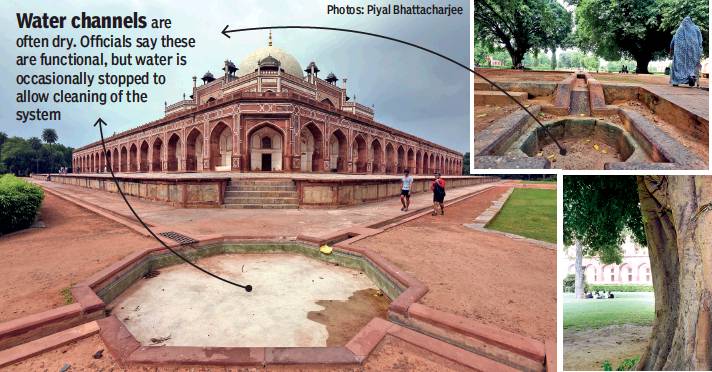
From: August 12, 2018: The Times of India
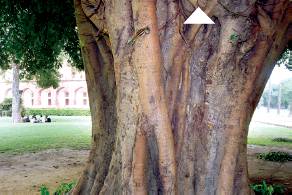
From: August 12, 2018: The Times of India

From: August 12, 2018: The Times of India
Humayun’s Tomb is one of the three world heritage sites in Delhi. It’s also one of the most well-maintained heritage sites in the country. And yet, visitor experience here isn’t necessarily as good as its upkeep is.
The lush green chaharbagh gardens having a smattering of trees, the shining golden pinnacle, the elaborate calligraphy etched in stone, and the imposing Mughal edifice all make for a happy snap. But how much information is an average visitor getting out of this monument? Minimum.
There are about 160 graves here, but who are buried in these graves isn’t known except for the generic information that they all belonged to the Mughal royal family and nobility spanning several centuries. The water channels are mostly dry, while the numerous trees at the tomb complex aren’t marked either. The Quranic verses in beautiful calligraphy, but without translations, are mistaken for design patterns.
ASI says a forthcoming interpretation centre at the tomb complex, expected to open next year, would fill up these gaps. Its partner in managing the site, Aga Khan Trust for Culture, is doing a research project to determine the names of those buried at the site.
ASI said water channels are fully functional, but water is stopped for cleaning.
Baoli (well)
Restored in 2019
Mohammad Ibrar, August 20, 2019: The Times of India
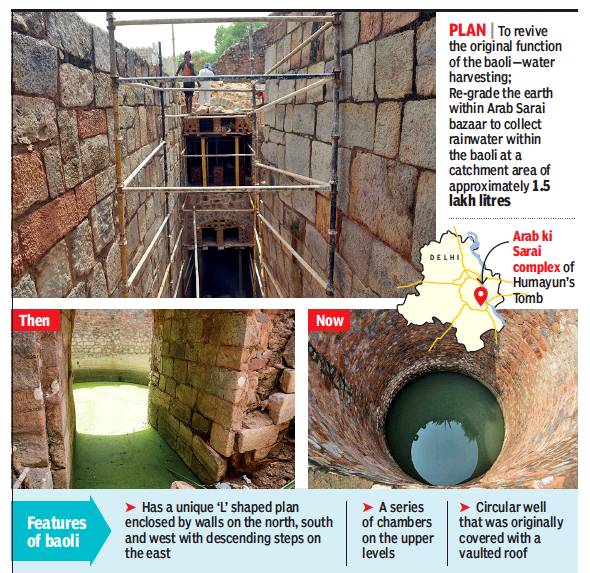
From: Mohammad Ibrar, August 20, 2019: The Times of India
Baoli at Humayun’s Tomb complex gets a facelift
New Delhi:
The Aga Khan Trust for Culture (AKTC) has started conservation of a stepwell or baoli in the Arab ki Sarai complex of Humayun’s Tomb.
According to AKTC, the baoli is of a unique ‘L’ shaped plan enclosed by walls on the north, south and west with descending steps on the east, with a series of chambers on the upper levels. “This early 17th-century baoli comprises a circular well accessed by a steep flight of steps – originally covered with a vaulted roof. The roof has since collapsed and many structural elements in the baoli have collapsed or are in an advanced state of collapse. The main walls of the stepwell were bulging beyond repair and required urgent measures to prevent further deterioration,” explained AKTC conservation architect Ratish Nanda.
“The idea behind the conservation is to revive the original function of the baoli—water harvesting. We plan to regrade the earth within Arab Sarai bazaar to collect rainwater within the baoli at a catchment area of approximately 1.5 lakh litres,” Nanda said.
He added that AKTC will conserve the baoli with the support of Germany. Work is already underway and will get over by the end of the year.
Nanda also said that the work is part of AKTC’s conservation effort in the Nizamuddin area.
“The complex is believed to have been built under the patronage of Mughal emperor Jahangir and would have served traders who stopped here to sell their wares,” AKTC said.
A group of master craftsmen are at present repairing the structure using traditional material and methods. Effort is on to structurally consolidate the adjoining masonry and reconstruct the collapsed vaults of the baoli chambers.
Vikramjit Singh Rooprai, the author of ‘Delhi Heritage Top 10 Baolis’, informed that the area of the baoli is called Meherban Agha’s Mandi and that the structure’s foundation is so strong that “there is a possibility that there was a structure above it”.
In his book, Rooprai writes that to the south of Arab Sarai was a vegetable market built during the reign of Emperor Jahangir by a eunuch named Meherban Agha.
“The stepwell has its own unique architecture. The well is towards the south and a tank is extended to the north. Steps lead to a platform above the tank from north to south. This platform gives access to the well.”
Rooprai informed that this baoli measures 90 feet by 46 feet and is the second smallest after Loharheri Baoli in Dwarka. The complex came up in the 16th century.
Sabz Burj
Status in 2018
Renovation work to give back Subz Burj its Mughal glory, January 14, 2018: The Times of India
It was the tomb of an unknown Mughal noble. At some point, it even served as the local police station of Nizamuddin. Today, it’s a landmark used by traffic police and drivers when explaining directions for the area. It’s popularly (and mistakenly) called Subz Burj. In reality, this monument has much more to it.
It’s one of the earliest Mughal-era structures. A unique building, it is richly ornamented with incised plasterwork, glazed ceramic tiles, wall paintings and decorative lattice stonework. The structure has suffered due to poor conservation in the past. The facade has been damaged, ornamentation has been lost, and there has been an impact of pollution too.
Damage to the external and internal facade, loss of ornamentation work and high levels of pollution due its location at a roundabout where thousands of vehicles cross the monument daily. The project started in November 2017.
Arab Ki Serai
Status as in 2019

From: Richi Verma, Mughal baoli suffering from neglect hits road to revamp, March 27, 2019: The Times of India

From: Richi Verma, Mughal baoli suffering from neglect hits road to revamp, March 27, 2019: The Times of India
16TH-CENTURY STEPWELL NEAR HUMAYUN’S TOMB FINDS HOPE
The 16th-century Arab Ki Serai complex near world heritage site Humayun’s Tomb was designed to meet the needs of traders. Built in 1560 by Hamida Bano Begum, the chief consort of Emperor Humayun, to accommodate 300 Arabs she had brought back from Mecca.
The bazaar had rooms to store and display material and a baoli there provided water. Over the last three centuries, the baoli was neglected and is today in a state of partial collapse. Now, it will be thoroughly conserved as part of a project that will start this month.
The work will be handled by Aga Khan Trust for Culture (AKTC), which has received financial support from the German embassy. As per experts, at the turn of the last century, there were over 100 stepwells in Delhi that played a very important role in storing rainwater. “Gradually, many of these incredible structures were filled up to build upon the valuable land they stood on,” said an official.
The project will try to replicate the success of conservation at Nizamuddin baoli that AKTC had pulled off a few years ago. That baoli, an ASI protected monument, had collapsed, requiring five years of painstaking conservation work in close consultation with the community of Nizamuddin Basti.
The German embassy had earlier supported the conservation of Chaunsath Khambha. German ambassaddor to India Dr Martin Ney said his country has contributed over Rs 10 crore since the 1980s to conserve over 50 monuments in India.
Officials say the bazaar and baoli at Arab Ki Serai are in a state of partial collapse with some of the walls being beyond repair. “This baoli comprises a circular well accessed by a steep flight of steps, originally covered by a vaulted roof. The roof has since collapsed as have the walls of the steps, and the circular well is showing severe deterioration. It will take a year to restore the structure,” said an official.
AKTC also plans to re-grade the earth within the bazaar and adjoining areas of Nizamuddin East, which will help in collecting rainwater.
